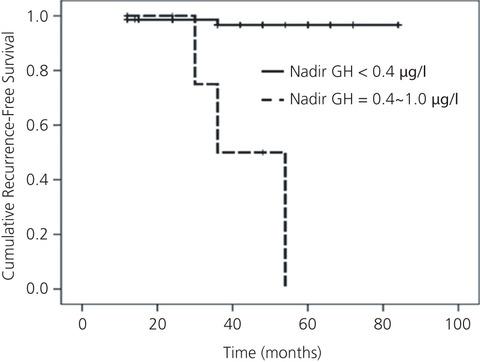当前位置:
X-MOL 学术
›
J. Neuroendocrinol.
›
论文详情
Our official English website, www.x-mol.net, welcomes your feedback! (Note: you will need to create a separate account there.)
2010 versus the 2000 consensus criteria in patients with normalised insulin-like growth factor 1 after transsphenoidal surgery has high predictive values for long-term recurrence-free survival in acromegaly
Journal of Neuroendocrinology ( IF 3.2 ) Pub Date : 2021-05-16 , DOI: 10.1111/jne.12958 Ming Shen 1, 2, 3, 4, 5, 6 , Zhengyuan Chen 1, 2, 3, 4, 5 , Xuefei Shou 1, 2, 3, 4, 5, 6 , Wenqiang He 1, 2, 3, 4, 5 , Nidan Qiao 1, 2, 3, 4, 5 , Zengyi Ma 1, 2, 3, 4, 5 , Zhao Ye 1, 2, 3, 4, 5 , Yichao Zhang 1, 2, 3, 4, 5 , Qilin Zhang 1, 2, 3, 4, 5 , Xiang Zhou 1, 2, 3, 4, 5, 6 , Xiaoyun Cao 1, 2, 3, 4, 5 , Zhaoyun Zhang 5, 7, 8 , Hongying Ye 5, 7 , Yiming Li 5, 7 , Yao Zhao 1, 2, 3, 4, 5, 6, 8 , Shiqi Li 1, 2, 3, 4, 5 , Min He 5, 7 , Yongfei Wang 1, 2, 3, 4, 5, 6
Journal of Neuroendocrinology ( IF 3.2 ) Pub Date : 2021-05-16 , DOI: 10.1111/jne.12958 Ming Shen 1, 2, 3, 4, 5, 6 , Zhengyuan Chen 1, 2, 3, 4, 5 , Xuefei Shou 1, 2, 3, 4, 5, 6 , Wenqiang He 1, 2, 3, 4, 5 , Nidan Qiao 1, 2, 3, 4, 5 , Zengyi Ma 1, 2, 3, 4, 5 , Zhao Ye 1, 2, 3, 4, 5 , Yichao Zhang 1, 2, 3, 4, 5 , Qilin Zhang 1, 2, 3, 4, 5 , Xiang Zhou 1, 2, 3, 4, 5, 6 , Xiaoyun Cao 1, 2, 3, 4, 5 , Zhaoyun Zhang 5, 7, 8 , Hongying Ye 5, 7 , Yiming Li 5, 7 , Yao Zhao 1, 2, 3, 4, 5, 6, 8 , Shiqi Li 1, 2, 3, 4, 5 , Min He 5, 7 , Yongfei Wang 1, 2, 3, 4, 5, 6
Affiliation

|
The present study investigated the factors associated with recurrence during long-term follow-up in acromegaly and compared the recurrence rate between patients in remission with 2010 vs 2000 consensus criteria. We retrospectively recruited 133 adult acromegalic patients who had undergone transsphenoidal surgery (TSS) from January 2013 to December 2014 and assessed their clinical characteristics, surgical outcomes and recurrence. Surgical remission was defined as normalised insulin-like growth factor 1 (IGF-1) with nadir growth hormone (GH) during an oral glucose tolerance test (OGTT) < 1 μg/ L no less than 3 months after TSS without adjuvant therapy. Recurrence was defined as persistently reelevated IGF-1 after surgical remission. Cox regression analysis and Kaplan-Meier survival analysis were performed to evaluate the factors associated with recurrence. Remission was achieved in 77 cases (57.9%) after TSS alone. Recurrence was seen in five cases (6.5%) at 12, 12, 12, 36 and 54 months, respectively, after surgery. Cox regression analysis showed that a nadir GH < 0.4 μg /L (vs 0.4-1.0 μg /L) at surgical remission (odds ratio [OR] = 0.106; 95% confidence interval [CI] = 0.017-0.645; P = 0.015) and Ki-67 index (OR = 2.636; 95% CI = 1.023-6.791; P = 0.045) were independent factors influencing recurrence. Kaplan-Meier survival analysis showed that the median recurrence-free survival was 36 months (95% CI = 20-52) for patients with nadir GH 0.4-1.0 μg /L at surgical remission. The median recurrence-free survival for patients with nadir GH < 0.4 μg /L at surgical remission was much longer (ie, required further follow-up to estimate). A failure of GH suppression under 0.4 μg /L during an OGTT in patients with normalised IGF-1 and a higher Ki-67 index are independent predictors of recurrence after surgical remission in GH-secreting pituitary adenomas. Compared to patients with nadir GH < 0.4 μg /L, those with nadir GH 0.4-1.0 μg /L appear to have a significantly higher risk of recurrence.
中文翻译:

2010 年与 2000 年共识标准在经蝶手术后胰岛素样生长因子 1 正常化的患者中对肢端肥大症患者的长期无复发生存具有较高的预测价值
本研究调查了肢端肥大症长期随访期间与复发相关的因素,并将缓解期患者的复发率与 2010 年与 2000 年共识标准进行了比较。我们回顾性招募了 2013 年 1 月至 2014 年 12 月期间接受经蝶手术 (TSS) 的 133 名成人肢端肥大症患者,并评估了他们的临床特征、手术结果和复发情况。手术缓解定义为在没有辅助治疗的 TSS 后不少于 3 个月的口服葡萄糖耐量试验 (OGTT) 期间,胰岛素样生长因子 1 (IGF-1) 和最低点生长激素 (GH) 的标准化程度<1 μg/L。复发被定义为手术缓解后IGF-1持续升高。进行Cox回归分析和Kaplan-Meier生存分析以评估与复发相关的因素。仅 TSS 后 77 例 (57.9%) 获得缓解。术后 12、12、12、36 和 54 个月分别有 5 例(6.5%)复发。Cox 回归分析显示,手术缓解时的最低 GH < 0.4 μg /L(对比 0.4-1.0 μg /L)(优势比 [OR] = 0.106;95% 置信区间 [CI] = 0.017-0.645;P = 0.015)和 Ki-67 指数(OR = 2.636;95% CI = 1.023-6.791;P = 0.045)是影响复发的独立因素。Kaplan-Meier 生存分析显示,手术缓解时最低 GH 0.4-1.0 μg /L 的患者中位无复发生存期为 36 个月(95% CI = 20-52)。手术缓解时最低 GH < 0.4 μg /L 的患者的中位无复发生存期要长得多(即,需要进一步随访才能估计)。IGF-1 正常化和 Ki-67 指数较高的患者在 OGTT 期间 GH 抑制失败低于 0.4 μg/L 是 GH 分泌垂体腺瘤手术缓解后复发的独立预测因素。与最低点 GH < 0.4 μg /L 的患者相比,最低点 GH 0.4-1.0 μg /L 的患者似乎具有显着更高的复发风险。
更新日期:2021-05-28
中文翻译:

2010 年与 2000 年共识标准在经蝶手术后胰岛素样生长因子 1 正常化的患者中对肢端肥大症患者的长期无复发生存具有较高的预测价值
本研究调查了肢端肥大症长期随访期间与复发相关的因素,并将缓解期患者的复发率与 2010 年与 2000 年共识标准进行了比较。我们回顾性招募了 2013 年 1 月至 2014 年 12 月期间接受经蝶手术 (TSS) 的 133 名成人肢端肥大症患者,并评估了他们的临床特征、手术结果和复发情况。手术缓解定义为在没有辅助治疗的 TSS 后不少于 3 个月的口服葡萄糖耐量试验 (OGTT) 期间,胰岛素样生长因子 1 (IGF-1) 和最低点生长激素 (GH) 的标准化程度<1 μg/L。复发被定义为手术缓解后IGF-1持续升高。进行Cox回归分析和Kaplan-Meier生存分析以评估与复发相关的因素。仅 TSS 后 77 例 (57.9%) 获得缓解。术后 12、12、12、36 和 54 个月分别有 5 例(6.5%)复发。Cox 回归分析显示,手术缓解时的最低 GH < 0.4 μg /L(对比 0.4-1.0 μg /L)(优势比 [OR] = 0.106;95% 置信区间 [CI] = 0.017-0.645;P = 0.015)和 Ki-67 指数(OR = 2.636;95% CI = 1.023-6.791;P = 0.045)是影响复发的独立因素。Kaplan-Meier 生存分析显示,手术缓解时最低 GH 0.4-1.0 μg /L 的患者中位无复发生存期为 36 个月(95% CI = 20-52)。手术缓解时最低 GH < 0.4 μg /L 的患者的中位无复发生存期要长得多(即,需要进一步随访才能估计)。IGF-1 正常化和 Ki-67 指数较高的患者在 OGTT 期间 GH 抑制失败低于 0.4 μg/L 是 GH 分泌垂体腺瘤手术缓解后复发的独立预测因素。与最低点 GH < 0.4 μg /L 的患者相比,最低点 GH 0.4-1.0 μg /L 的患者似乎具有显着更高的复发风险。



























 京公网安备 11010802027423号
京公网安备 11010802027423号